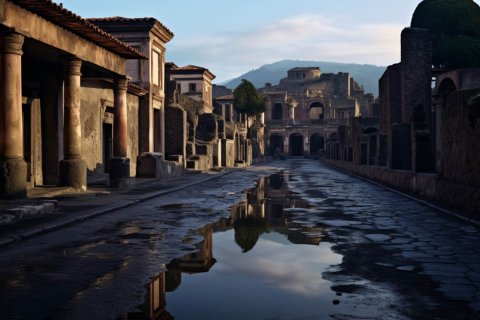Pompeii: Explore the Ancient City with a Private Archaeologist
Embark on a captivating journey through the western part of Pompeii with a comprehensive private tour guided by an archaeologist. Step back in time and unravel the rich history of each corner of this ancient Roman city.
About this ActivityDiscover the wonders of one of the world's premier archaeological sites with a knowledgeable guide. Immerse yourself in the daily life of Romans before the eruption of Mount Vesuvius, exploring all the key highlights of Pompeii.
HighlightsExperience the authentic atmosphere of Pompeii with a private guide. Gain insights into Roman life as you visit significant landmarks such as Marina gate, the forum, the basilica, the temple of Jupiter, the Stabian Baths, the house of Menander, the brothel, theaters, plaster casts of victims, shops, and fountains.
A stroll in Pompeii is an intense experience, offering a glimpse into a town frozen in time. Delve into the history of the town, understand how Romans lived, and marvel at public buildings and private houses.
What's Included- Disposable earphones for larger groups due to COVID-19 precautions
- Guided tour of Pompeii by a certified archaeologist-guide
- Skip-the-line admission fees
Meeting PointMeet your guide at the Pompeii main gate, "Porta Marina Superiore," in front of the bar-restaurant Hortus — the building adorned with lemons and oranges.
Important InformationComfortable shoes are recommended, and pets and umbrellas are not allowed. Entrance is free on the first Sunday of each month, but reservations are not possible, so entry is not guaranteed.
Book your spot now to explore Pompeii with flexibility and pay nothing today.
Customer ReviewsOverall Rating: 4.9/5 based on 116 reviews
Guide: 4.9/5 | Value for Money: 4.5/5 | Service: 4.9/5 | Organization: 4.9/5
This guided tour stands out as the best ever experienced, with an outstanding guide, Laura, who was warm, knowledgeable, and accommodating. Visitors praised the tour's value for money and the flexibility it offered.
Paola, another guide, received accolades for her in-depth knowledge of Pompeii, the volcano, eruption, excavation, and preservation process, making the tour a memorable experience.
Michele's expertise shone in a fantastic tour, with visitors expressing gratitude for the insightful journey through Pompeii, uncovering details they might have otherwise missed.
Book now for an unforgettable exploration of Pompeii's ancient wonders!
Entering through the Marina Gate, life before the eruption in PompeiiMarina Gate, also known as the Sea Gate, was one of the main entrances to the ancient city of Pompeii. This monumental gate opened towards the Bay of Naples and played a crucial role in the city's maritime activities. As visitors pass through this gate, they are transported to a bygone era, witnessing the daily life, commerce, and culture that thrived within the walls of Pompeii.
Life before the eruption:
Before the tragic events of 79 AD, Pompeii was a bustling Roman city with a rich tapestry of life. The streets were lined with shops, homes, and public buildings. Markets bustled with activity as merchants sold their goods, and citizens engaged in social and recreational activities. The city boasted an amphitheater, temples, and bathhouses, reflecting the sophistication of Roman urban planning.
Art and Architecture:
The city's architecture and artwork provide glimpses into the daily lives and beliefs of its inhabitants. Lavish frescoes adorned the walls of affluent homes, depicting scenes of mythological stories, landscapes, and domestic life. The Forum, a central public space, was surrounded by impressive structures, including the Temple of Jupiter and the Basilica, showcasing the grandeur of Roman civic architecture.
The Eruption of Mount Vesuvius:
Despite the vibrancy of Pompeian life, the looming threat of Mount Vesuvius was an ever-present reality. In 79 AD, the volcano unleashed its fury, burying the city under layers of ash and pumice. The sudden and catastrophic event preserved Pompeii remarkably well, providing archaeologists and historians with a unique snapshot of ancient Roman life.
Archaeological Discoveries:
Excavations at Pompeii have unearthed an extraordinary wealth of artifacts, offering insights into the daily routines, social structure, and economic activities of its residents. From well-preserved mosaics to everyday utensils, these discoveries paint a vivid picture of the people who called Pompeii home.
FAQs:
What is the significance of Marina Gate?
The Marina Gate served as a crucial entry point to Pompeii, connecting the city to maritime trade and activities. It symbolizes the city's economic and cultural ties with the wider Roman world.
How did the eruption impact Pompeian life?
The eruption of Mount Vesuvius led to the sudden and tragic destruction of Pompeii. The volcanic ash preserved the city, allowing modern archaeologists to uncover valuable insights into ancient Roman civilization.
What are some notable discoveries at Pompeii?
Archaeologists have uncovered a plethora of artifacts, including frescoes, mosaics, household items, and even the casts of Pompeii's residents. These discoveries contribute to our understanding of Roman art, architecture, and daily life.



